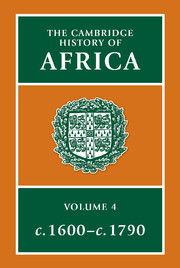Book contents
- Frontmatter
- Introduction
- 1 Egypt, the Funj and Darfur
- 2 The central Sahara and Sudan
- 3 North-West Africa: from the Maghrib to the fringes of the forest
- 4 The Guinea coast
- 5 Central Africa from Cameroun to the Zambezi
- 6 Southern Africa and Madagascar
- 7 Eastern Africa
- 8 Ethiopia and the Horn of Africa
- 9 Africa in Europe and the Americas
- Bibliographical Essays
- Bibliography
- Index
- References
7 - Eastern Africa
Published online by Cambridge University Press: 28 March 2008
- Frontmatter
- Introduction
- 1 Egypt, the Funj and Darfur
- 2 The central Sahara and Sudan
- 3 North-West Africa: from the Maghrib to the fringes of the forest
- 4 The Guinea coast
- 5 Central Africa from Cameroun to the Zambezi
- 6 Southern Africa and Madagascar
- 7 Eastern Africa
- 8 Ethiopia and the Horn of Africa
- 9 Africa in Europe and the Americas
- Bibliographical Essays
- Bibliography
- Index
- References
Summary
Variety of experience is perhaps the most striking feature of the history of eastern Africa during the seventeenth and eighteenth centuries. Along the coast this vast region stretches southwards from Mogadishu to the mouth of the Zambezi river. Inland it extends from the southern Ethiopian escarpment and the southern Sudan down along the western edge of the great lakes region, across the corridor between Lakes Tanganyika and Malawi, and then follows the Luangwa river until its confluence with the Zambezi. In the northern interior – including most of modern Kenya, Uganda, Rwanda, and Burundi – both Nilotic-speaking and Bantu-speaking peoples were still isolated from the coast, still able to resolve their problems without having to confront the economic and allied challenges that would emanate from the coast in the nineteenth century. In the central interior – encompassing most of the Tanzanian mainland – it is possible to see a gradual transition by the end of the eighteenth century from the northern pattern of historical development to that of the southern interior – comprising what is today southern Tanzania, northern Mozambique, Malawi, and the eastern-most region of Zambia – where the main challenge to the Bantu-speaking peoples was the growth and impact of international trade. On the coast, the various Swahili-speaking communities were already concerned to preserve what they could of their ancient political and economic independence from two successive sets of overlords, the Portuguese and the Omani Arabs. Yet throughout these two centuries it is also possible to discern common processes at work in these four regions of eastern Africa.
- Type
- Chapter
- Information
- The Cambridge History of Africa , pp. 469 - 536Publisher: Cambridge University PressPrint publication year: 1975
References
- 23
- Cited by



